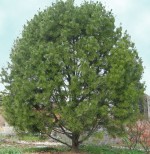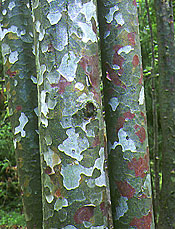 We had a specimen lacebark pine on the front lawn of our Annapolis home and it gave us a great deal of pleasure for many years. It was one of several hundred the head gardener grafted at his New Jersey nursery ten years before we planted it in Annapolis. The tree was multi-stemmed and grew slowly into a graceful pyramidal form. The medium green needles were fairly long and gave an medium texture to the tree but the real eye stopper was the exfoliating bark that created white, green, gray, and reddish brown patches on the trunks. We saw many of these trees in China where they are planted around temples and in classical Chinese gardens. They are valued for their beauty there as well as their longevity and some are said to be over 1000 years old. I guess the climate where they grow in China is more benign than ours, as we had serious problems with ice and snow in Annapolis. Lacebark pines are brittle and both branches and trunks snap when covered with a heavy wet snow or thick ice. Our beloved lacebark pine ended up with only one stem as a result of several years of winter storms and then wind toppled it over in a severe thunder storm.
We had a specimen lacebark pine on the front lawn of our Annapolis home and it gave us a great deal of pleasure for many years. It was one of several hundred the head gardener grafted at his New Jersey nursery ten years before we planted it in Annapolis. The tree was multi-stemmed and grew slowly into a graceful pyramidal form. The medium green needles were fairly long and gave an medium texture to the tree but the real eye stopper was the exfoliating bark that created white, green, gray, and reddish brown patches on the trunks. We saw many of these trees in China where they are planted around temples and in classical Chinese gardens. They are valued for their beauty there as well as their longevity and some are said to be over 1000 years old. I guess the climate where they grow in China is more benign than ours, as we had serious problems with ice and snow in Annapolis. Lacebark pines are brittle and both branches and trunks snap when covered with a heavy wet snow or thick ice. Our beloved lacebark pine ended up with only one stem as a result of several years of winter storms and then wind toppled it over in a severe thunder storm.
This is an outstanding pine and is an asset in any garden whether planted as a specimen or in groups. Lacebark pines have the desirable traits of very young trees have exfoliating bark when the branches are only about an inch in diameter and they hold their needles about five years, longer than most pines. In addition, its picturesque habit of growing with several major trunks adds to its beauty.
Type: Evergreen tree (three-needle pine).
 Outstanding Feature: Exfoliating bark.
Outstanding Feature: Exfoliating bark.
Form: Pyramidal to rounded; often multi-stemmed with low branches; flat topped in maturity.
Growth Rate: Slow.
Cones: 2-3” terminal or lateral.
Size: 30-50’ H x 20-35’ W.
Light: Full sun.
Soil: Average, well-drained; medium drought tolerant once established.
Hardiness: Zones 4-8.
Care: Low maintenance.
Pests and Diseases: None of importance.
Propagation: Seed; grafting.
Comments: Resistant to deer and rabbits.
